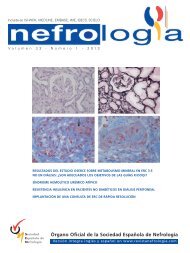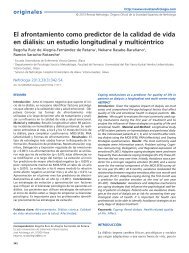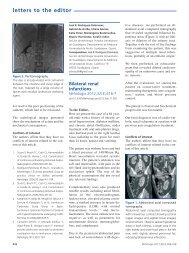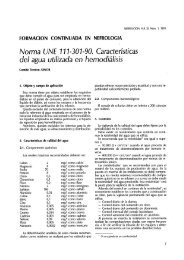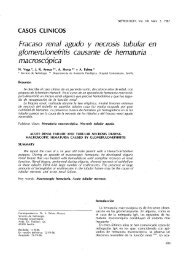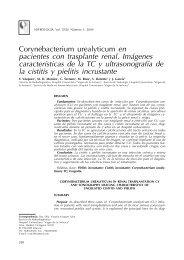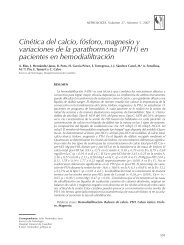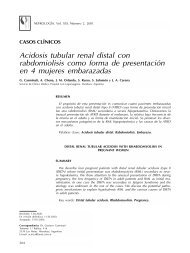PDF Número - NefrologÃa
PDF Número - NefrologÃa
PDF Número - NefrologÃa
You also want an ePaper? Increase the reach of your titles
YUMPU automatically turns print PDFs into web optimized ePapers that Google loves.
originales<br />
Carmelo Iborra-Moltó et al. Adhesión a la restricción de líquidos<br />
Prevalence of adherence to fluid restriction<br />
in kidney patients in haemodialysis: objective indicator<br />
and perceived compliance<br />
ABSTRACT<br />
Introduction: Studies of adherence to fluid restriction<br />
show high variability in prevalence data, as different methods<br />
of measuring IWG (interdialysis weight gain) and<br />
cut-off criteria are used. Objectives: To describe the prevalence<br />
of adherence to fluid restriction using daily IWG (criterion:<br />
90kg, IWG=1.3kg/day) and to<br />
study the association between this objective indicator and<br />
adherence behaviour as reported by patient. Patients and<br />
method: Our study included a total of 146 patients with a<br />
mean age of 66 years (SD: 13.6 years; range: 25-88 years),<br />
66% of which were male. Ours was a longitudinal study<br />
with one month of follow-up. We collected both sociodemographic<br />
and clinical variables and mean daily IWG. Patient-reported<br />
adherence behaviour was assessed through<br />
an interview by a trained staff member from outside the<br />
department who asked the following question: “In order<br />
to avoid complications between haemodialysis sessions: during<br />
the last month, how many days did you ingest less than<br />
1 litre of fluid per day?” (0= no days; 10= every day). A score<br />
5 led to categorisation of patients as compliant with<br />
treatment. Statistical analysis included descriptive analysis,<br />
correlation test, chi-squareand Crosstabs, ROC curve and logistic<br />
regression procedures. Results: Prevalence of “objective”<br />
adherence to fluid restriction was 61% (mean daily<br />
IWG1kg) and 73% (mean daily IWG adjusted for dry<br />
weight). Reported adherence (prevalence: 56.2%) was associated<br />
with IWG adjusted for weight (chi-square =31.34;<br />
P=.000). In patients with objective adherence adjusted for<br />
weight, the prevalence of reported adherence was 1.65 times<br />
that of non-adherence (PR=1.65; 95% CI: 1.29-2.11).<br />
The final model for estimating the association between reported<br />
adherence behaviour and daily adjusted IWG included:<br />
age (higher), dry weight (lower), potassium (lower),<br />
time on haemodialysis treatment (less) and its interaction<br />
with reported behaviour (F=50.70; P=.000; R2=44%). The<br />
sensitivity of reported adherence behaviour for detecting<br />
objective adherence adjusted for dry weight was 89%; specificity<br />
was 58%, and the overall classification power was<br />
85% (AUC=.85; 95% CI: 0.78-0.92). The probability of objective<br />
adherence adjusted for weight in patients who claimed<br />
proper adherence was 9 times higher than in noncompliant<br />
patients in patients who had been on HD for 2.3<br />
years (POR p25<br />
=9.16; 95% CI: 2.58-32.51); 6 times higher in<br />
patients on HD for 4.7 years (POR P50<br />
=6.16; 95% CI: 2.12-<br />
17.92); and 3 times higher in those on HD for 8.2 years<br />
(POR p75<br />
=3.44; 95% CI: 1.32-8.96). Conclusions: Prevalence of<br />
adherence to fluid restriction was 73% and 16% depending<br />
on daily IWG adjusted/not adjusted for dry weight, respectively.<br />
Absolute daily IWG adjusted for weight seems a<br />
good indicator of adherence, as it allows for a personalised<br />
fluid restriction regimen. Significant association between<br />
this objective indicator and reported adherence behaviour<br />
supports a combination of patient approach and objective<br />
data, which can help with the adjustment of the individual<br />
cut-off for daily IWG. This also provides useful information<br />
for designing intervention strategies to maintain and increase<br />
adherence.<br />
Keywords: Adherence. Perceived compliance. Chronic kidney<br />
disease. Interdialytic weight gain. Haemodialysis. Fluid status.<br />
Dry weight.<br />
478<br />
INTRODUCCIÓN<br />
El control de la ingesta de líquidos es fundamental para el autocuidado<br />
de los pacientes renales en hemodiálisis (HD). Sin<br />
embargo, la experiencia clínica muestra que, comparado con<br />
la asistencia a las sesiones de HD o con la prescripción de<br />
fármacos, ése es el aspecto del tratamiento donde se produce<br />
mayor grado de incumplimiento 1-5 .<br />
En la literatura revisada, la pauta de ingesta diaria total de líquidos<br />
que debe tomar un paciente renal en anuria tratado con<br />
HD ha variado desde indicaciones restrictivas, de 0,5 y 0,9 litros/día<br />
6,7 , hasta recomendaciones mucho más permisivas 2 . En<br />
nuestro entorno se ha adoptado una pauta de consenso que recomienda<br />
una ingesta máxima en un paciente anúrico de 1 litro/día.<br />
Esta indicación tiene en cuenta las necesidades basales<br />
y el contenido hídrico de los diferentes tipos de alimentos 8 .<br />
Estudios recientes avalan esta pauta, ya que cuando el líquido<br />
extracelular sobrepasa el 15%, se puede hablar de hiperhidratación,<br />
la cual se asocia a hipertensión y a menor supervivencia<br />
9 . Además, mediante el análisis de bioimpedancia, se ha observado<br />
que la normohidratación en el paciente renal se<br />
establece aproximadamente en 2 litros entre sesiones, siendo<br />
ésta la ganancia óptima para reducir los eventos adversos intradiálisis<br />
en un 75% y el riesgo de mortalidad al 50% 9-11 .<br />
En general, hay acuerdo en que la ganancia de peso entre dos<br />
sesiones de hemodiálisis (ganancia de peso interdiálisis [GID])<br />
está directamente relacionada con la ingesta de líquidos y, por<br />
tanto, es un buen indicador de la conducta de adhesión a la restricción<br />
hídrica 3 . Existe una alta variabilidad en los datos sobre<br />
prevalencia de adhesión, ya que se estudia con distintos métodos<br />
de medida de la GID y se aplican diferentes criterios o puntos<br />
de corte que establecen si hay o no adhesión.<br />
Uno de los métodos es estimar la GID en términos relativos,<br />
calculando el porcentaje de incremento de peso inter-HD sobre<br />
el peso seco de cada paciente, bien entre dos sesiones, bien<br />
hallando la media durante un período de tiempo. Estas medidas<br />
se basan en que la cantidad tolerable de ingesta total de líquidos<br />
sin que se produzcan complicaciones a corto y medio<br />
plazo varía en función del peso seco, de forma que, a mayor<br />
peso, se tolera mayor porcentaje de ganancia de peso entre sesiones.<br />
En este sentido, hay estudios que han mostrado que,<br />
cuanto mayor es la GID, mejor es el estado nutricional (tomando<br />
como indicador la tasa de catabolismo proteico) 1,12-16 .<br />
Entre otras cosas, concluyen que cuando la GID es menor del<br />
3% del peso seco existe riesgo de malnutrición 15 , aunque<br />
cuando la ganancia es mayor de 5,7% el riesgo de mortalidad<br />
se incrementa en un 35% 1 . Sin que se haya establecido de un<br />
modo concreto, los resultados apoyan individualizar las prescripciones<br />
y la adopción de criterios permisivos para la ganancia<br />
de peso 1,12,17 . Así, la principal ventaja de las estimaciones<br />
relativas es que individualizan la pauta y permiten una<br />
ingesta de líquido mayor en pacientes con mayor peso. Con<br />
el criterio del límite superior del 5,7%, los datos de prevalen-<br />
Nefrologia 2012;32(4):477-85



